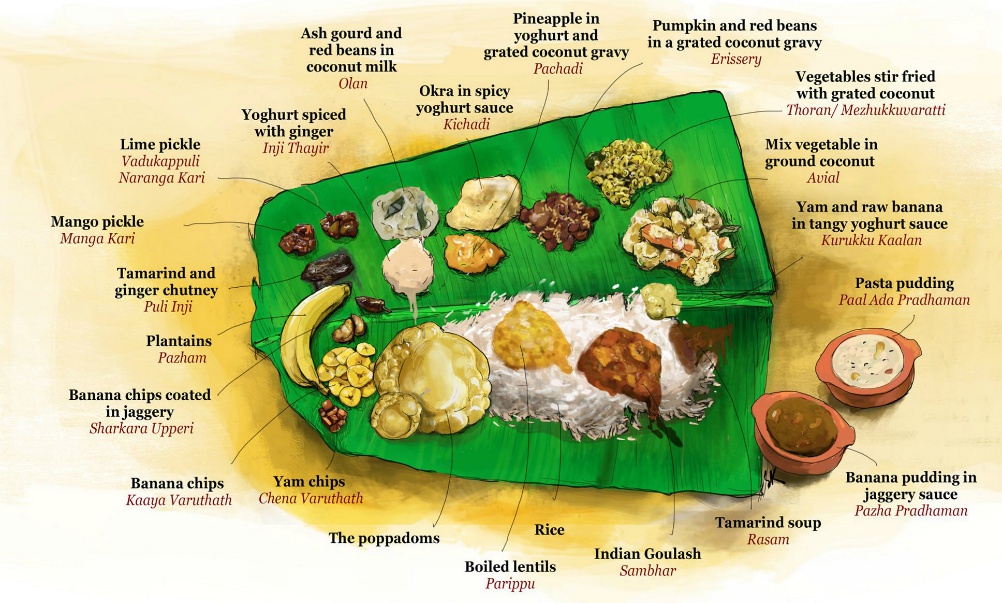Onam is a joyful harvest festival that is celebrated with great enthusiasm in Kerala. But it’s not just a Kerala thing! Celebrated across India, Onam marks the return of King Mahabali, as he visits his people during this festive time. And what better way to honour this joyous occasion than through food with Chef Nehal Karkera? The heart of Onam is the Sadya, a traditional vegetarian feast that delights the taste buds & unites people in celebration.
About Chef Nehal
Chef Nehal Karkera is a professional chef & content creator based in Mumbai, India, with over 15 years of experience in the food & beverage industry. He is currently involved as a full-time food content creator on various social media platforms. With a rich background in the culinary field, he has also worked for eight years at an Italian restaurant in Mumbai and also gained experience with the Disney Cruise Line. His diverse experience allows him to bring a wide range of culinary skills to his content.
Also Read: Know About Yashashree Rao On Being National Crush, her True Self & Reacting On Fan Tweets On The Social Nation Show
The Heart of Sadya
The charm of Sadya is in its simplicity and presentation. Imagine sitting on the floor with a vibrant banana leaf in front of you, adorned with a colorful spread of dishes. At its core, Sadya features generous servings of rice, sambhar, and rasam, alongside a delightful mix of vegetable dishes, various curries, pickles, and chutneys adding a spicy kick.
What’s special about Sadya is how well everything is blended together the mild curries, tangy pickles, crunchy papadam, and sweet dessert create a perfectly balanced meal.

Onam Ki Kahani, Chef Nehal Ki Zubaani
When we sat down with Chef Nehal, to chat about Onam and the Sadya feast, his passion for the festival shone through. He explained, “Onam is the most vibrant celebration of Kerala’s culture and heritage, and the highlight is the Sadya meal. It’s a feast that represents abundance, togetherness, and the joy of sharing. The Sadya is served on a banana leaf, which is not just a plate but a symbol of humility, purity, and connection with nature.
Sambar, a tangy lentil curry, deepens the meal with spice. Parippu is a comforting dal with ghee, showcasing Kerala’s humble roots. Avial combines vegetables, symbolizing nature’s bounty. Olan, a mild coconut milk dish, adds a soothing contrast to the feast.
Kaalan, a tangy yoghurt curry, adds festive richness. Erissery, with pumpkin and cowpeas, symbolizes prosperity. Thoran and Mezhukkupuratti offer a crunchy, simple touch, while rasam, a spicy soup, balances it all perfectly.
A Sadya isn’t complete without the crunch of pappadam, pickles for a sharp kick, and the sweetness of banana chips and sharkara upperi. It all ends with payasam, a sweet that’s the essence of any celebration, bringing joy and fond memories. For me, Onam Sadya is more than food—it’s a celebration of tradition, values, and the togetherness that makes Onam truly special.“
The tradition of serving Sadya on a banana leaf also has a practical aspect. The banana leaf imparts a unique flavour to the food & is biodegradable, making it an eco-friendly choice. Plus, it’s huge, so there’s plenty of room for all the delicious dishes!
Sequence Of Sadya Service: A Delicious Ritual
Now, you might wonder, how does one tackle a Sadya meal? It’s not as simple as piling everything onto the leaf & digging in. There’s a method where each item is served in a specific sequence.
First, the banana leaf is placed in the dining area, with the wide end facing the guest. The leaf is cleaned and slightly folded to prevent any spills.
Payasam: The meal usually ends with a sweet dessert called Payasam, made with ingredients like rice, lentils, or vermicelli, and flavoured with cardamom, nuts, and raisins.
Rice: The meal begins with a generous serving of rice placed in the center of the leaf. This is the base for the entire meal.
Sambar: Next, a portion of Sambar (a spicy lentil and vegetable stew) is served alongside the rice. It’s often poured over the rice to mix with it.
Rasam: Rasam, a tangy and spicy soup, is served in a small portion, usually next to the Sambar.
Vegetable Curries: Various vegetable curries (like Avial, Olan, and Kalan) are placed around the rice. These are made with a mix of vegetables, coconut, and yoghurt.
Thoran: A dry stir-fry of vegetables with coconut, like Cabbage Thoran or Beans Thoran, is served on the side.
Pickles and Chutneys: Pickles (like Mango or Lime) and a variety of chutneys are added to enhance the flavours.
Pachadi: A yogurt-based dish mixed with fruits or vegetables, such as Pineapple Pachadi or Cucumber Pachadi, is served for a refreshing taste.
Kalan: A thick curry made with yoghurt and vegetables, Kalan adds a rich, tangy flavour to the meal.
Banana & Papadam: Slices of ripe banana and crispy papadam (fried lentil wafers) are served as accompaniments.

A Celebration Of Unity, Culture, & Abundance
While Onam is a festival rooted in Kerala’s rich history & traditions, its message of unity, abundance, and celebration transcends borders. It’s a reminder that no matter where we’re from, good food & good company are at the heart of every meaningful celebration.
From the intricate, floral Pookalam designs that adorn doorsteps to the lively boat races & cultural performances, Onam is more than just a regional festival. It’s a celebration that connects with people across India. But perhaps the most delicious part of it all is the Sadya feast, where flavours mix with the spirit of community & sharing.
So, whether you’re in Kerala or celebrating Onam from afar, indulging in a Sadya meal is the perfect way to join in the festive spirit. Experience the flavours, culture, and unity, all wrapped up in one beautiful meal.


